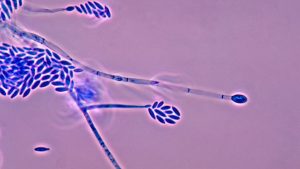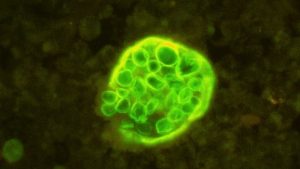#092: Gyromitrin and Monomethylhydrazine (MMH)
These toxins are primarily found in the genus Gyromitra (false morels) and can be fatal in high doses. Gyromitrin poisoning accounts for about 2% to 4% of mushroom-related fatalities.
Most gyromitrin poisonings are the result of misidentification of false morels. Although they somewhat resemble the true morels, even the novice mushroom hunter should be able to tell the false morels apart. First of all, the stipe is solid, unlike the hollow stipe found in true morels. Secondly, the head of a false morel is only attached at the very top of the stipe. In true morels, there is no gap between the head and the stipe for at least half the length of the head. Finally, the head of a false morel is characterized by many, irregular wrinkles, which are easily distinguished from the well-formed ridges and pits found on the head of a true morel. Some people routinely eat false morels, but this is ill-advised, due to reasons discussed further down.
Gyromitrin is the form of the toxin found in the mushrooms themselves. It is a fairly small compound, consisting of only 15 atoms (for the chemists out there, one of its chemical names is: acetaldehyde-N-methyl-N-formylhydrazone). Once in your digestive tract, it quickly breaks down into a compound called N-methyl-N-formylhydrazine (MFH) and acetaldehyde. The former chemical then slowly hydrolyzes (breaks apart in the presence of water) to monomethylhydrazine (MMH, a.k.a. methylhydrazine or MH). MMH is a small molecule with the formula: H2N-NH-CH3 (the N-N single bond is the “hydrazine” part of the compound, while the CH3 group is the “methyl” part). This tiny compound is responsible for the symptoms of gyromitrin poisoning. As a side note, MMH has also been used as rocket fuel by the U.S. military.
There are a number of related compounds, all of which are based on hydrazine and have similar symptoms and physiological effects. These molecules can be found in low concentrations in a variety of mushrooms, including related ascomycetes as well as Agaricus bisporus, the grocery store mushroom. In most of these, the toxins are not present in high enough concentrations to cause any symptoms. When only present in low concentrations, the toxins can be cooked off without risk of poisoning. Always cook edible mushrooms before eating them.
Gyromitrin and MMH are volatile liquids and can easily be removed by parboiling. This may seem like a quick fix to make false morels edible, but this process carries its own risks. The toxins are released into the air during parboiling and can be inhaled, which will also result in poisoning (which can be fatal if exposure is frequent or prolonged). Additionally, a significant amount of gyromitrin can be left behind in the mushroom, in which case you can still get poisoned from eating the parboiled mushroom. The amount of gyromitrin present in a mushroom varies widely between species, populations, and individuals, so the amount of parboiling required is not consistent. Given the risks and uncertainties, it is best to avoid eating false morels altogether.
The onset of gyromitrin poisoning is delayed and usually starts between 5 and 10 hours after ingestion or between 2 and 8 hours after inhalation. Symptoms of mild to moderate poisoning mimic those of food poisoning and include: bloating, abdominal cramps, diarrhea, vomiting, and nausea. In cases of severe poisoning, the toxins start to affect the central nervous system, break down red blood cells, and in rare cases damage the liver and kidney or alter the structure of hemoglobin (methemoglobinemia). Typical symptoms of severe gyromitrin poisoning include: severe food poisoning symptoms, weakness, lack of energy, jaundice, headaches, loss of coordination, delirium, seizures, coma, and death.
MMH damages the nervous system by interfering with the neurotransmitters GABA, glutamic acid, and glutamate. GABA is an inhibitory neurotransmitter and is needed for proper regulation of neuronal signals. MMH blocks the activity of pyridoxine kinase, thus making vitamin B6 unusable. Vitamin B6 is used in a variety of enzymatic reactions, including the production of GABA. As a result, neurons cannot produce enough GABA to effectively control neuronal signaling.
MMH also interferes with the enzyme glutamic acid decarboxylase (GAD), which converts glutamic acid into glutamate. This enzyme is used in the production of GABA, so blocking GAD also results in decreased levels of GABA. Additionally, glutamic acid and glutamate are excitatory neurotransmitters, so inhibiting GAD further disrupts the balance of neurotransmitters in the nervous system. These effects can cause neurons to misfire, thus resulting in the symptoms of delirium, seizures, and loss of coordination.
There are a myriad of other biochemical pathways that are disrupted by MMH, but for many of these we do not know exactly how they work. For example, the process by which MMH destroys red blood cells is not well understood. We do know, however, that the destruction of red blood cells makes it more difficult for the body to transport oxygen, which causes the symptoms of weakness and lack of energy. In addition to its toxic effects, studies done with animals have demonstrated that MMH damages DNA and is carcinogenic.
Because of the detrimental impact of MMH on a variety of biochemical processes, you should probably avoid eating false morels altogether. Pregnant women and young children should definitely avoid eating them, as some studies have suggested MMH can result in birth defects or developmental abnormalities.
Treatment of gyromitrin poisoning generally focuses on treating the symptoms rather than getting rid of the MMH already in the patient’s body. If the patient gets to the hospital early enough, drinking activated charcoal may help prevent some of the toxins from entering the blood stream. Unfortunately, because of the delayed onset of symptoms, most people probably arrive at the hospital too late for this to be effective. At this point, the hospital must treat the symptoms and let the patient’s body slowly get rid of the MMH (this usually takes 1 to 2 days).
Severe food poisoning often results in dehydration, electrolyte imbalance, and low blood sugar. All of these can be monitored and corrected by hospital staff. If the patient is symptomatic for hemoglobin damage, the condition can be treated by the administration of methylene blue. As the liver and kidney can be damaged by MMH, the hospital may also monitor liver and kidney function. Seizures can be treated by benzodiazepenes, pyridoxine, phenobarbitol or propofol. Pyridoxine is a form of Vitamin B6 and may have antidotal properties, but its effects appear to be limited at best. Still, administration of Vitamin B6 should help restore some cellular functions.
See Further:
http://www.mykoweb.com/TFWNA/P-37.html
http://botit.botany.wisc.edu/toms_fungi/may2002.html
http://toxnet.nlm.nih.gov/cgi-bin/sis/search/a?dbs+hsdb:@term+@DOCNO+3489
http://pubchem.ncbi.nlm.nih.gov/compound/methylhydrazine#section=Top







![#011: Characteristics of Kingdom Fungi [Archived]](https://www.fungusfactfriday.com/wp-content/themes/hueman/assets/front/img/thumb-small-empty.png)



2 Responses
[…] Of course, you should always cook your mushrooms before you eat them. Even uncooked A. bisporus mushrooms are known to contain the toxic compound monomethylhydrizine (see FFF#092). […]
[…] never eat any species of Gyromitra, since those mushrooms all potentially contain gyromitrin (see FFF#092), which breaks down in the body to become the toxin monomethylhydrazine (MMH).2,6 Some people do […]